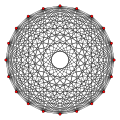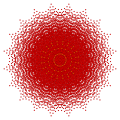 10-orthoplex |
 Rectified 10-orthoplex |
 Birectified 10-orthoplex |
 Trirectified 10-orthoplex |
 Quadirectified 10-orthoplex |
 Quadrirectified 10-cube |
 Trirectified 10-cube |
 Birectified 10-cube |
 Rectified 10-cube |
 10-cube | ||
| Orthogonal projections in A10 Coxeter plane | |||
|---|---|---|---|
In ten-dimensional geometry, a rectified 10-orthoplex is a convex uniform 10-polytope, being a rectification of the regular 10-orthoplex.
There are 10 rectifications of the 10-orthoplex. Vertices of the rectified 10-orthoplex are located at the edge-centers of the 9-orthoplex. Vertices of the birectified 10-orthoplex are located in the triangular face centers of the 10-orthoplex. Vertices of the trirectified 10-orthoplex are located in the tetrahedral cell centers of the 10-orthoplex.
These polytopes are part of a family 1023 uniform 10-polytopes with BC10 symmetry.
Rectified 10-orthoplex
| Rectified 10-orthoplex | |
|---|---|
| Type | uniform 10-polytope |
| Schläfli symbol | t1{38,4} |
| Coxeter-Dynkin diagrams | |
| 7-faces | |
| 6-faces | |
| 5-faces | |
| 4-faces | |
| Cells | |
| Faces | |
| Edges | 2880 |
| Vertices | 180 |
| Vertex figure | 8-orthoplex prism |
| Petrie polygon | icosagon |
| Coxeter groups | C10, [4,38] D10, [37,1,1] |
| Properties | convex |
In ten-dimensional geometry, a rectified 10-orthoplex is a 10-polytope, being a rectification of the regular 10-orthoplex.
Rectified 10-orthoplex
The rectified 10-orthoplex is the vertex figure for the demidekeractic honeycomb.
















 or
or 


















Alternate names
- rectified decacross (Acronym rake) (Jonathan Bowers)[1]
Construction
There are two Coxeter groups associated with the rectified 10-orthoplex, one with the C10 or [4,38] Coxeter group, and a lower symmetry with two copies of 9-orthoplex facets, alternating, with the D10 or [37,1,1] Coxeter group.
Cartesian coordinates
Cartesian coordinates for the vertices of a rectified 10-orthoplex, centered at the origin, edge length are all permutations of:
- (±1,±1,0,0,0,0,0,0,0,0)
Root vectors
Its 180 vertices represent the root vectors of the simple Lie group D10. The vertices can be seen in 3 hyperplanes, with the 45 vertices rectified 9-simplices facets on opposite sides, and 90 vertices of an expanded 9-simplex passing through the center. When combined with the 20 vertices of the 9-orthoplex, these vertices represent the 200 root vectors of the simple Lie group B10.
Images
| B10 | B9 | B8 |
|---|---|---|

|

|

|
| [20] | [18] | [16] |
| B7 | B6 | B5 |

|

|

|
| [14] | [12] | [10] |
| B4 | B3 | B2 |

|

|

|
| [8] | [6] | [4] |
| A9 | A5 | |
| — | — | |
| [10] | [6] | |
| A7 | A3 | |
| — | — | |
| [8] | [4] | |
Birectified 10-orthoplex
| Birectified 10-orthoplex | |
|---|---|
| Type | uniform 10-polytope |
| Schläfli symbol | t2{38,4} |
| Coxeter-Dynkin diagrams | |
| 7-faces | |
| 6-faces | |
| 5-faces | |
| 4-faces | |
| Cells | |
| Faces | |
| Edges | |
| Vertices | |
| Vertex figure | |
| Coxeter groups | C10, [4,38] D10, [37,1,1] |
| Properties | convex |
Alternate names
- Birectified decacross
Cartesian coordinates
Cartesian coordinates for the vertices of a birectified 10-orthoplex, centered at the origin, edge length are all permutations of:
- (±1,±1,±1,0,0,0,0,0,0,0)
Images
| B10 | B9 | B8 |
|---|---|---|

|

|

|
| [20] | [18] | [16] |
| B7 | B6 | B5 |

|

|

|
| [14] | [12] | [10] |
| B4 | B3 | B2 |

|

|

|
| [8] | [6] | [4] |
| A9 | A5 | |
| — | — | |
| [10] | [6] | |
| A7 | A3 | |
| — | — | |
| [8] | [4] | |
Trirectified 10-orthoplex
| Trirectified 10-orthoplex | |
|---|---|
| Type | uniform 10-polytope |
| Schläfli symbol | t3{38,4} |
| Coxeter-Dynkin diagrams | |
| 7-faces | |
| 6-faces | |
| 5-faces | |
| 4-faces | |
| Cells | |
| Faces | |
| Edges | |
| Vertices | |
| Vertex figure | |
| Coxeter groups | C10, [4,38] D10, [37,1,1] |
| Properties | convex |
Alternate names
- Trirectified decacross (Acronym trake) (Jonathan Bowers)[2]
Cartesian coordinates
Cartesian coordinates for the vertices of a trirectified 10-orthoplex, centered at the origin, edge length are all permutations of:
- (±1,±1,±1,±1,0,0,0,0,0,0)
Images
| B10 | B9 | B8 |
|---|---|---|

|

|

|
| [20] | [18] | [16] |
| B7 | B6 | B5 |

|

|

|
| [14] | [12] | [10] |
| B4 | B3 | B2 |

|

|

|
| [8] | [6] | [4] |
| A9 | A5 | |
| — | — | |
| [10] | [6] | |
| A7 | A3 | |
| — | — | |
| [8] | [4] | |
Quadrirectified 10-orthoplex
| Quadrirectified 10-orthoplex | |
|---|---|
| Type | uniform 10-polytope |
| Schläfli symbol | t4{38,4} |
| Coxeter-Dynkin diagrams | |
| 7-faces | |
| 6-faces | |
| 5-faces | |
| 4-faces | |
| Cells | |
| Faces | |
| Edges | |
| Vertices | |
| Vertex figure | |
| Coxeter groups | C10, [4,38] D10, [37,1,1] |
| Properties | convex |
Alternate names
- Quadrirectified decacross (Acronym brake) (Jonthan Bowers)[3]
Cartesian coordinates
Cartesian coordinates for the vertices of a quadrirectified 10-orthoplex, centered at the origin, edge length are all permutations of:
- (±1,±1,±1,±1,±1,0,0,0,0,0)
Images
| B10 | B9 | B8 |
|---|---|---|

|

|

|
| [20] | [18] | [16] |
| B7 | B6 | B5 |

|

|

|
| [14] | [12] | [10] |
| B4 | B3 | B2 |

|

|

|
| [8] | [6] | [4] |
| A9 | A5 | |
| — | — | |
| [10] | [6] | |
| A7 | A3 | |
| — | — | |
| [8] | [4] | |
Notes
References
- H.S.M. Coxeter:
- H.S.M. Coxeter, Regular Polytopes, 3rd Edition, Dover New York, 1973
- Kaleidoscopes: Selected Writings of H.S.M. Coxeter, edited by F. Arthur Sherk, Peter McMullen, Anthony C. Thompson, Asia Ivic Weiss, Wiley-Interscience Publication, 1995, ISBN 978-0-471-01003-6 [1]
- (Paper 22) H.S.M. Coxeter, Regular and Semi Regular Polytopes I, [Math. Zeit. 46 (1940) 380-407, MR 2,10]
- (Paper 23) H.S.M. Coxeter, Regular and Semi-Regular Polytopes II, [Math. Zeit. 188 (1985) 559-591]
- (Paper 24) H.S.M. Coxeter, Regular and Semi-Regular Polytopes III, [Math. Zeit. 200 (1988) 3-45]
- Norman Johnson Uniform Polytopes, Manuscript (1991)
- N.W. Johnson: The Theory of Uniform Polytopes and Honeycombs, Ph.D. (1966)
- Klitzing, Richard. "10D uniform polytopes (polyxenna)". x3o3o3o3o3o3o3o3o4o - ka, o3x3o3o3o3o3o3o3o4o - rake, o3o3x3o3o3o3o3o3o4o - brake, o3o3o3x3o3o3o3o3o4o - trake, o3o3o3o3x3o3o3o3o4o - terake, o3o3o3o3o3x3o3o3o4o - terade, o3o3o3o3o3o3x3o3o4o - trade, o3o3o3o3o3o3o3x3o4o - brade, o3o3o3o3o3o3o3o3x4o - rade, o3o3o3o3o3o3o3o3o4x - deker

